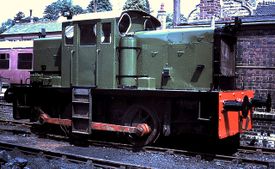John Fowler 150hp Diesel Shunter No 17 Highflyer
| John Fowler 150hp Diesel Shunter No 17 Highflyer | |
|---|---|
 No. 17 'Highflyer' at Bridgnorth in 1972 (David Cooke) | |
| Built By | John Fowler & Co |
| Configuration | 0-4-0DM |
| Power type | Diesel Mechanical |
| Status | Scrapped |
| Loco Number | 17 |
| Other Numbers | Works No 22912/1940 |
| History | |
| Built | 1940 |
| Type | 150 h.p. diesel mechanical |
| 1971 | Arrived on SVR on loan |
| 1981 | Engine failure leading to scrapping |
John Fowler 0-4-0DM shunter No 17 ‘Highflyer’ was the SVR’s first diesel locomotive. It arrived in 1971 and was used on engineers’ trains until 1981, when it suffered a catastrophic engine failure. It was scrapped the following year.
Contents
No 17 in service
No 17 was built by John Fowler & Co of Leeds as Works No 22912 of 1940. It was a 150 h.p. Diesel Mechanical 0-4-0 shunter and was delivered new to the Royal Ordnance Factory at Swynnerton near Stone, Staffordshire in July 1940. In 1958 the locomotive moved to another Royal Ordnance Factory at Chorley Lancashire where it was given the number 17. However it soon became surplus to requirements there and was transferred to the Longmoor Military Railway, where it was used as an instructional locomotive for diesel fitters and engineering training.[1]
No 17 in preservation
No 17 was initially acquired by the Dart Valley Railway Association. It was offered to the SVR on loan and arrived by road at Bridgnorth on 10 April 1971. It was the first Diesel locomotive on the SVR and by coincidence, the 17th locomotive to arrive overall.[1] It was put to work on engineers’ trains and was photographed working at Bewdley South Junction later that year.[2] By spring 1972 it had been purchased by the SVR and repainted in fully lined out LNER express passenger livery by Bob Timmins and Gordon Allen, who also gave it the nickname "Highflyer".[3][4] In October 1973 It was used to drag new timber baulks into place during the first refurbishment of the Cleobury Road Bridge at Bridgnorth.[5]
In summer 1973 No17 was based at Bridgnorth, acting as standby locomotive for Ruston 319290.[6] However it continued to see use up and down the line and on Sunday 2nd August 1976, during the 'long hot summer', No 17 took a spare Hawksworth 4,000 gallon tender to Spring Grove near the Devil's Spittleful (Rifle Range) Bridge to supply water to the Hereford and Worcestershire County Fire Brigade who were fighting a major forest fire which raged for several days.[7]
No 17’s working life on the SVR ended in 1981,[8] when the locomotive suffered a major engine failure while working an engineers’ train on the Waterworks straight en route to Bridgnorth. The engine’s crank-shaft broke and a con rod went through the side of the engine block. After this failure No 17 was stored at Eardington, before being moved to Highley where it was broken up in July 1982.[4]
See Also
References
- ↑ 1.0 1.1 SVR Stock Book Sixth Edition
- ↑ SVR News 25
- ↑ SVR News 23
- ↑ 4.0 4.1 SVR News 133
- ↑ SVR News 31
- ↑ SVR News 28
- ↑ SVR News 41
- ↑ SVR News 60
| ||||||||||||||||||||||||||||||||||||||||||||||||||||||||||||||||||||||||